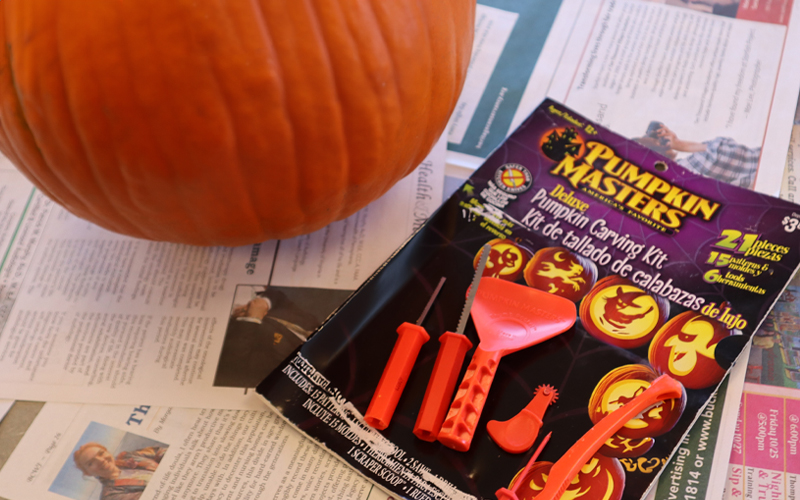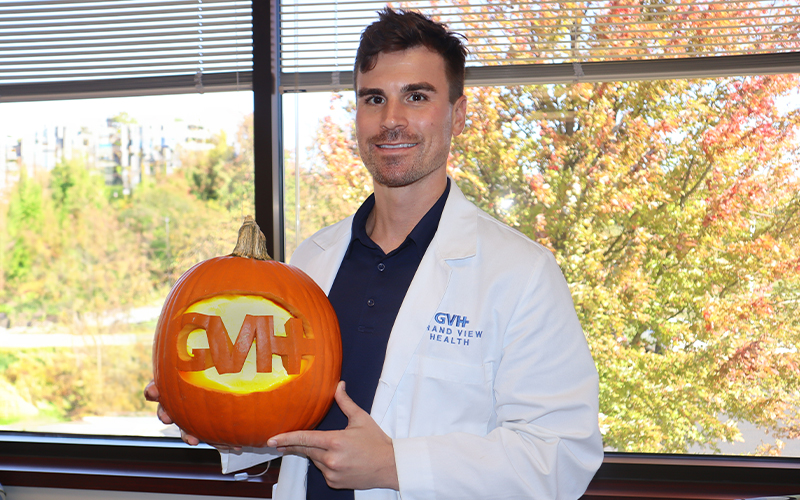
Gathering the family around the kitchen table for pumpkin carving is one of the most time-honored Halloween traditions. And while creating a handmade jack-o-lantern is lots of fun, it also can be dangerous if you’re not careful.
“About 2,000 people need emergency room care every year due to a pumpkin carving accident,” says Colin Ackerman, MD, a fellowship-trained hand surgeon with Upper Bucks Orthopaedics at Grand View Health. “And unfortunately, many of these injuries can be serious, sometimes requiring surgery and months of rehabilitation.”
You can keep pumpkin carving festive – and avoid serious injuries – by knowing the risks and following a few simple safe carving tips. Let’s dig deeper into common carving injuries, how they happen, and how you can prevent them.
Most common pumpkin carving injuries
A recent medical study evaluated pumpkin carving injuries over a 10-year period. Nearly 90% of all injuries studied involved the hand or fingers, with one-third involving the index finger and another 25% involving the thumb.
“The most common type of injuries are lacerations, which are deep cuts to the hands and fingers,” Dr. Ackerman says. “These types of injuries may also damage tendons and nerves, affecting the motion and sensation in your hands.”
Children ages 10 – 19 are most likely to be injured during pumpkin carving. Incidents most often happen on weekends. And Oct. 30 – the day before Halloween – is the most likely date for an injury.
Leading causes of carving injuries
Carving injuries can happen for a variety of reasons. Three of the most common are using the wrong tools, applying too much force while carving, and holding the pumpkin improperly.
“The skin of a pumpkin is thick – thicker than most people think,” Dr. Ackerman says. “This causes people to choose knives that are too sharp. And because pumpkins are round and slippery, they’re very difficult to keep steady.”

Top tips for safe carving
To keep you and your family safe and happy this Halloween season, Dr. Ackerman recommends these jack-o-lantern carving safety tips:
Prepare a safe carving station. Plan to carve your pumpkin in a well-lit, dry area on a stable surface, such as a kitchen table or a cutting board on a kitchen countertop.
Use the right tools. Avoid large kitchen knives that aren’t designed for carving. Instead, buy a pumpkin carving kit from a local store. They cost between $12 – $20 and include tools that are easier to grip and designed for safety.
Saw, don’t stab. Sure, it’s tempting to start your carving ceremony off with a sharp stab to the top of the pumpkin. But don’t do it. “If you’re using a large kitchen knife, your hand could slip off the grip and slide down the serrated edge of the knife,” Dr. Ackerman warns. Instead, start carving by using a gentle sawing motion, and don’t rush.
Cut in the opposite direction of your hand. Place your hand on top of the pumpkin and cut away from the fingers to reduce the risk of index finger or thumb injuries.
Don’t put your hand inside the pumpkin when carving. Dig out all pumpkin seeds before you start carving and don’t try to balance the pumpkin by putting your hand inside it while cutting.
Leave carving to the adults. Ask your kids to help in other ways, such as scooping the seeds out of the pumpkin with a spoon or drying off the seeds for baking later.
Remove distractions. Kids and adults can get silly while pumpkin carving but do your best to stay as focused as possible while carving.
Keep wet and dry washcloths nearby. Pumpkin carving is messy. Wipe off carving tools regularly and wipe down the pumpkin from time to time to keep the area dry.
Skip the carving altogether. Consider other fun ways to make a jack-o-lantern, including using stickers or markers.
What to do if you hurt your hand
If you do suffer a cut on your hand or fingers during pumpkin carving, apply pressure to the wound to stop bleeding, then wash the cut with soap and water. Once the bleeding stops, apply an antibiotic ointment to the wound and cover it with a sterile bandage. “If the cut is deep or bleeding doesn’t stop within 10 minutes of pressure, head to the Emergency Room immediately,” Dr. Ackerman says.
Learn more about care for hands, wrists and elbows Grand View Health.

